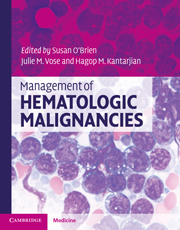Book contents
- Frontmatter
- Contents
- List of contributors
- 1 Molecular pathology of leukemia
- 2 Management of acute myeloid leukemia
- 3 Treatment of acute lymphoblastic leukemia (ALL) in adults
- 4 Chronic myeloid leukemia
- 5 Chronic lymphocytic leukemia/small lymphocytic lymphoma
- 6 Myelodysplastic syndromes (MDS)
- 7 Hairy cell leukemia
- 8 Acute promyelocytic leukemia: pathophysiology and clinical results update
- 9 Myeloproliferative neoplasms
- 10 Monoclonal gammopathy of undetermined significance, smoldering multiple myeloma, and multiple myeloma
- 11 Amyloidosis and other rare plasma cell dyscrasias
- 12 Waldenstrom's macroglobulinemia/lymphoplasmacytic lymphoma
- 13 WHO classification of lymphomas
- 14 Molecular pathology of lymphoma
- 15 International staging and response criteria for lymphomas
- 16 Treatment approach to diffuse large B-cell lymphomas
- 17 Mantle cell lymphoma
- 18 Follicular lymphomas
- 19 Hodgkin lymphoma: epidemiology, diagnosis, and treatment
- 20 Treatment approaches to MALT/marginal zone lymphoma
- 21 Peripheral T-cell lymphomas
- 22 Mycosis fungoides and Sézary syndrome
- 23 Central nervous system lymphoma
- 24 HIV-related lymphomas
- 25 Lymphoblastic lymphoma
- 26 Burkitt lymphoma
- Index
- References
3 - Treatment of acute lymphoblastic leukemia (ALL) in adults
Published online by Cambridge University Press: 10 January 2011
- Frontmatter
- Contents
- List of contributors
- 1 Molecular pathology of leukemia
- 2 Management of acute myeloid leukemia
- 3 Treatment of acute lymphoblastic leukemia (ALL) in adults
- 4 Chronic myeloid leukemia
- 5 Chronic lymphocytic leukemia/small lymphocytic lymphoma
- 6 Myelodysplastic syndromes (MDS)
- 7 Hairy cell leukemia
- 8 Acute promyelocytic leukemia: pathophysiology and clinical results update
- 9 Myeloproliferative neoplasms
- 10 Monoclonal gammopathy of undetermined significance, smoldering multiple myeloma, and multiple myeloma
- 11 Amyloidosis and other rare plasma cell dyscrasias
- 12 Waldenstrom's macroglobulinemia/lymphoplasmacytic lymphoma
- 13 WHO classification of lymphomas
- 14 Molecular pathology of lymphoma
- 15 International staging and response criteria for lymphomas
- 16 Treatment approach to diffuse large B-cell lymphomas
- 17 Mantle cell lymphoma
- 18 Follicular lymphomas
- 19 Hodgkin lymphoma: epidemiology, diagnosis, and treatment
- 20 Treatment approaches to MALT/marginal zone lymphoma
- 21 Peripheral T-cell lymphomas
- 22 Mycosis fungoides and Sézary syndrome
- 23 Central nervous system lymphoma
- 24 HIV-related lymphomas
- 25 Lymphoblastic lymphoma
- 26 Burkitt lymphoma
- Index
- References
Summary
Introduction
Acute lymphoblastic leukemia (ALL) is a neoplastic clonal disorder resulting from the maturation arrest of lymphoid progenitors. While both T-cell precursors and B-cell precursors can be transformed, greater than 85% of cases are derived from precursor B cells. Accumulation of lymphoblasts within the bone marrow can result in anemia, thrombocytopenia, and neutropenia. Symptoms of fatigue, bleeding, bruising, and infection are frequent initial manifestations of the disease. There are a number of ALL subtypes that are characterized by particular morphologic, immunophenotypic, cytogenetics, and molecular findings. Treatment of ALL in the pediatric population has been a success story in hematology/oncology, with cure rates approaching 80%. Unfortunately, a majority of adult patients, approximately 65%, succumb to their disease. The use of novel agents and the introduction of risk-adapted therapies, including stem cell transplantation (SCT), the identification of new molecular targets, and the application of pediatric treatment approaches to adult patients are promising strategies that offer hope to improve treatment outcomes for adults with this heterogeneous group of diseases.
Epidemiology/etiology
Incidence
ALL comprises 20% of newly diagnosed acute leukemias in adults. Approximately 5200 new cases were diagnosed in the United States in 2007, and 1420 patients died from the disease that year. Most cases occur de novo, though prior exposure to chemotherapy, especially topoisomerase II inhibitors and alkylating agents, is a risk factor for both ALL and acute myeloid leukemia (AML). Therapy-related leukemias are strongly associated with rearrangements of the MLL (mixed-lineage leukemia) gene located on chromosome 11q23.
- Type
- Chapter
- Information
- Management of Hematologic Malignancies , pp. 43 - 67Publisher: Cambridge University PressPrint publication year: 2010



